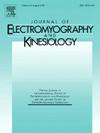重复瞄准鼠标对上肢远端肌肉疲劳和精细运动能力的影响
IF 2.3
4区 医学
Q3 NEUROSCIENCES
引用次数: 0
摘要
游戏要求很高,然而,游戏对肌肉疲劳和表现变化的影响尚不清楚。本研究的目的是评估延长小鼠瞄准疲劳方案期间的肌肉疲劳和表现障碍。招募了20名参与者(8F, 12 M),分为游戏组和非游戏组。测量右上肢远端8块肌肉的表面肌电图。参与者使用瞄准训练软件完成了一个30秒的瞄准任务。这项令人疲惫的计划包括六到五分钟的在AimLab中击中目标的回合。为了评估肌肉疲劳,在整个实验过程中收集了桡骨和尺侧偏差的参考收缩(最大30%)以及感知疲劳评分(RPF)。当瞄准老鼠时,手腕伸肌产生了最高水平的肌肉活动,产生了高达9.3%的MVC。在整个实验过程中,没有观察到性能指标的变化。然而,通过RPF、平均工频、中位数频率和尖峰形状分析,可以观察到伸肌的明显疲劳。性能指标表明,疲劳协议没有造成损害。肌电图特征的变化表明,由于长时间的鼠标瞄准,手腕伸肌变得明显疲劳,表明伸肌可能容易出现与游戏相关的疲劳和损伤。本文章由计算机程序翻译,如有差异,请以英文原文为准。
Impact of repetitive mouse aiming on muscle fatigue and fine motor performance of the distal upper limb
Gaming is demanding, however, the impact of gaming on muscle fatigue and performance changes is unclear. The purpose of this study was to evaluate muscle fatigue and performance impairments during an extended mouse aiming fatigue protocol. Twenty participants were recruited (8F, 12 M), separated into gaming and non-gaming groups. Surface electromyography was measured from eight muscles of the right distal upper limb. Participants performed a 30-second aiming task using aim training software. The fatiguing protocol involved six, 5-minute bouts of hitting targets in AimLab. To assess muscle fatigue, reference contractions of radial and ulnar deviation (30% max) as well as ratings of perceived fatigue (RPF) were collected throughout the experiment. The wrist extensors produced the greatest levels of muscle activity while aiming a mouse, producing up to 9.3% MVC. No changes in performance measures were observed throughout the experiment. However, significant fatigue of extensors was observed through changes in RPF, mean power frequency, median frequency, and spike shape analysis. Performance metrics indicated no impairments caused by the fatiguing protocol. Changes in EMG characteristics indicate that the wrist extensors became significantly fatigued through prolonged mouse aiming, indicating the extensors may be prone to gaming related fatigue and injury.
求助全文
通过发布文献求助,成功后即可免费获取论文全文。
去求助
来源期刊
CiteScore
4.70
自引率
8.00%
发文量
70
审稿时长
74 days
期刊介绍:
Journal of Electromyography & Kinesiology is the primary source for outstanding original articles on the study of human movement from muscle contraction via its motor units and sensory system to integrated motion through mechanical and electrical detection techniques.
As the official publication of the International Society of Electrophysiology and Kinesiology, the journal is dedicated to publishing the best work in all areas of electromyography and kinesiology, including: control of movement, muscle fatigue, muscle and nerve properties, joint biomechanics and electrical stimulation. Applications in rehabilitation, sports & exercise, motion analysis, ergonomics, alternative & complimentary medicine, measures of human performance and technical articles on electromyographic signal processing are welcome.

 求助内容:
求助内容: 应助结果提醒方式:
应助结果提醒方式:


